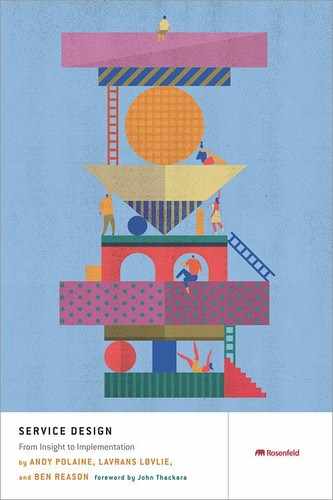0%
22Chapters
0-1Hours read
0kTotal Words
Book Description
Service Design is an eminently practical guide to designing services that work for people. It offers powerful insights, methods, and case studies to help you design, implement, and measure multichannel service experiences with greater impact for customers, businesses, and society.
Table of Contents
- Cover Page
- Title Page
- Copyright Page
- Dedication
- HOW TO USE THIS BOOK
- FREQUENTLY ASKED QUESTIONS
- Is service design just customer experience, user experience, or interaction design?
- Is service design “design thinking”?
- Why are there so many case studies from live|work?
- You do not mention [insert your favorite method here]. Why not?
- Where are your references and sources?
- What is the best way to convince management to spend money on service design?
- Are you saying that service design can do everything?
- CONTENTS
- FOREWORD
- CHAPTER 1 Insurance Is a Service, Not a Product
- CHAPTER 2 The Nature of Service Design
- Why Do Services Need Designing?
- How Services Differ from Products
- Services Created in Silos Are Experienced in Bits
- Services Are Co-produced by People
- A New Technological Landscape: The Network
- The Service Economy
- Core Service Values
- Making the Invisible Visible
- The Performance of Service
- Unite the Experience
- Summary
- CHAPTER 3 Understanding People and Relationships
- CHAPTER 4 Turning Research into Insight and Action
- CHAPTER 5 Describing the Service Ecology
- Why Map Service Ecologies?
- The Network Society
- Boxes versus Arrows—Finding the Invisible Connections
- From Ecology Map to Service Blueprint
- The Service Blueprint
- Different Uses of Blueprints
- Start with Broad Phases and Activities
- Add the Touchpoint Channels
- Low Fidelity versus High Fidelity
- Zooming In and Out
- Summary
- CHAPTER 6 Developing the Service Proposition
- CHAPTER 7 Prototyping Service Experiences
- Defining Experience
- Types of Experience
- Expectations versus Experiences
- Considering Time as an Object of Design
- Service Experience Prototyping
- Summary
- CHAPTER 8 Measuring Services
- Measurement for the Common Good
- Establishing a Truth with Management
- Apples and Oranges—Define Baseline Data before Design and Launch
- Making the Case for Return on Investment
- Using the Service Blueprint to Model Measurement
- Money Talks
- Avoiding Common Mistakes When Measuring Services
- Measurement Frameworks
- SERVQUAL and RATER
- The Triple Bottom Line
- Summary
- CHAPTER 9 The Challenges Facing Service Design
- Index
- Acknowledgments
- About the Authors
- Footnotes
